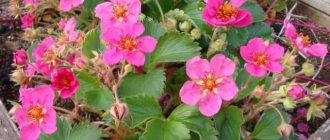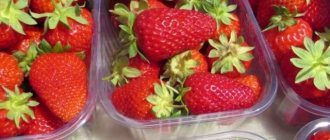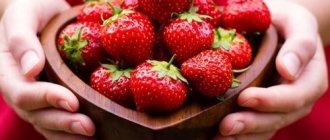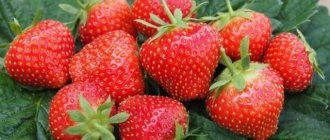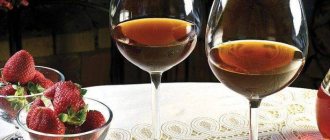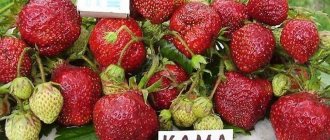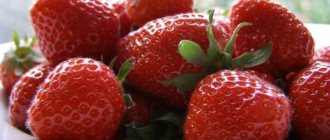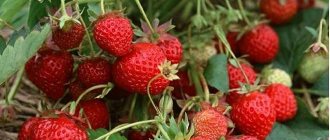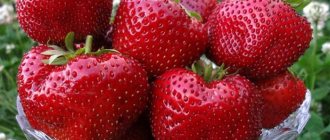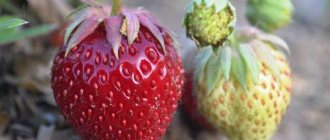There are varieties of strawberries about which almost everything is known. These are old, proven “fighters” on the berry front or new items that have already become favorites and have been successfully delighting us with their excellent harvests for many years. And there are those varieties around which an “aura of mystery” is created; information about them seems to be available, but there is either very little of it, or it is completely opposite. This often happens thanks to the Internet, because many sites thoughtlessly copy data from each other, distorting it and adding something of their own each time. The result is often simply fantastic stories that only confuse gardeners. Or they force you to make the wrong choice of plants to plant on your site. One of these “dark horses”, willy-nilly, became a British variety with a 30-year history - Malling Pandora or simply Pandora. But what this strawberry actually is and why there is so much conflicting data and incomprehensible characteristics about it - we will talk about this below.
Description of the variety
Bushes
The variety Molling Pandora is characterized by large, well-leafed bushes with a large number of powerful tendrils. The leaf blades are medium-sized, dark green, glossy, without pubescence, and sit on long petioles. Peduncles are numerous, flexible, located above the leaves. Even on annual plants, at least 10 of them are formed. Due to weak peduncles, berry clusters fall to the ground, however, even when in contact with the ground, including in rainy weather, the crop does not rot.
Berries
Pandora berries are large, round, and beautiful. The weight of the first fruits can reach 50 g or more. Subsequent berries are somewhat smaller (about 30 g), but despite this, they remain one-dimensional until the end of fruiting. The color of the berries is red, deep cherry when fully ripe.
The taste of the fruit is pleasant, dessert with a slight sourness. The pulp is dense, juicy, with a characteristic strawberry aroma. The seeds are small, deeply recessed into the surface of the fruit. Thanks to the fairly dense skin, the shelf life and transportability of the berries are at a high level. Collection is a little difficult - the tails break off hard.
Pandora pollen is sterile, so pollinating varieties must be planted next to it. When choosing them, you need to pay attention to the flowering time, for example, varieties Florence, Vikoda, Vikat, Tenira. As a safety net, you can also plant remontant varieties, which are characterized by almost continuous flowering.
Malling Pandora is not well suited for the southern regions. Late fruiting dates occur during the hottest and driest periods. The berry becomes smaller and withers.
Advantages and disadvantages
Pandora strawberries begin to bear fruit quite late, which allows you to increase the period of consumption of fresh berries by an average of two weeks. Plants have increased winter hardiness and, when cultivated in most regions of our country, do not require the use of additional shelter for the winter period.
Thanks to late flowering, fruit bearings are not negatively affected by spring return frosts. Strawberry bushes have sufficient endurance and have good immunity to many diseases of the root system, as well as powdery mildew.
The disadvantages of this hybrid form include the need to use pollinators, which are quite difficult to choose correctly, given the rather late flowering period, which is atypical for this type of plant. Optimal is the adjacent cultivation of strawberries of the Vikoda variety as a pollinator.
In addition, when growing, it should be taken into account that in wet weather the risk of rotting berries increases significantly, which is due to the fact that flower stalks with an abundant harvest of berries lie on wet soil. It is for this reason that it is recommended to mulch strawberry beds with hay or straw.
a brief description of
Advantages of the variety
- high productivity;
- large fruit;
- excellent taste, high sugar content even during rainy periods;
- high resistance to ticks;
- drought and frost resistance;
- a large number of whiskers for reproduction;
- late fruiting periods (in Central Russia, the second half of July to mid-August), when most varieties have already bear fruit.
No particular shortcomings have been identified in the variety; the only thing worth mentioning is its low resistance to spotting and other fungal diseases.
Spotting appears mainly on bushes suffering from insufficient watering, in the 2-3rd year of the plant’s life.
Distinctive features and characteristics
The foliage of the Molling Pandora strawberry has an original, slightly wrinkled surface. The color is light green, with a slight characteristic shine. The berries weigh 40-60 g, round, slightly cone-shaped. When fully ripe, the color on the outside is dark cherry.
Dimensions and appearance of the bush
Pandora strawberry bushes are sloping, up to 20 cm high, heavily leafy, accumulating a large amount of green mass, but compact. The leaf blades are located above the thin peduncles. The light green color of the foliage turns to dark green and then brown as cool autumn approaches.
The plant produces an average number of tendrils.
Flowering and pollinators
The Pandora strawberry variety produces a large number of flower stalks, up to a dozen in the first year, but it is self-sterile.
It cannot be grown without a pollen donor neighbor. Pollinators use strawberry plants with a similar flowering period. Strawberry varieties Florence, Vikoda, Malvina, Maxim, remontant Murano, Mariget are usually chosen as pollen donors.
Ripening time and yield per bush
Fruiting of Malling Pandora approximately begins in the second ten days of July. In the southern regions, the berries turn red 2 weeks earlier.
On average, 400 g of fruits are harvested from one bush, but provided that high-quality seedlings are used and all agricultural technology requirements are met, the yield from one plant will be 700-800 g. In the future, every year the yield of Pandora increases, but the sweetness of the berries decreases.
Composition and taste of fruits
Sweet with sourness, dessert, the taste of the fruit is reminiscent of wild strawberries. The berries are fragrant. Overripe fruits are the most delicious, but their shelf life and transportability decrease.
Pandora strawberry fruits are rich in vitamin C. About 60 mg per 100 g. In addition, they contain vitamins A, E, a wide vitamin B complex, various minerals and trace elements - potassium, calcium, magnesium, iron, sulfur, sodium.
Scope of application of berries
Due to the fairly high density of the fruit and the keeping quality above average, the Molling Pandora strawberry variety has universal use:
- fresh;
- for canning;
- for decorating baked goods and confectionery products.
Susceptibility to diseases and pests
The Pandora variety is highly resistant to powdery mildew and moderately resistant to Fusarium wilt. However, other diseases that usually affect strawberry plantations are poorly resisted.
Prolonged wet weather combined with errors in care can provoke:
- gray rot - manifested by the formation of fluffy gray plaque on the fruit in spots;
- leaf spot, noticeable by characteristic brown or white spots on the leaf blades.
Of the harmful insects, aphids most often occupy bushes of the Pandora variety. Spider mites attack the plant very rarely during prolonged heat and dry air and soil.
Frost and drought resistance
A plant that is completely ready for wintering can tolerate short-term frosts down to 20-22 °C without damage. If, due to weather conditions, the formation of buds is delayed and the process of preparation for the dormant period lasts until frost, many gardeners practice covering the bushes to be on the safe side.
Landing
To get a full harvest the next year after planting, strawberries are planted in late July - early August. The average yield of one-year-old plants, subject to agricultural technology, reaches 800 g per bush. In subsequent years it increases even more. The plantation remains profitable for 3 years, after which it is recommended to update it.
Attention! Planting strawberry seedlings in late autumn is not advisable. Plants do not have time to lay flower buds before the onset of frost. As a result, the next year they develop lush foliage, but there is no fruiting.
When planting seedlings, it is worth considering that Pandora bushes are large, so leave gaps of at least 40 cm between them, the distance between rows should be at least 50-60 cm.
Only the Malvina variety ripens later than the Molling Pandora strawberries (3-5 days later).
To establish a strawberry plantation, choose flat, well-lit areas without close groundwater. Wetlands and acidic soils are unsuitable for cultivation. Strawberries grow best on sandy loam soils and light loams with a neutral reaction of the soil substrate. Planting is carried out using a one- or two-line method. In this case, the length of the lines is limited only by the size of the sections.
Subtleties of growing a plant
To harvest a good harvest of large berries, Pandora strawberries need to be planted in fertile soil and follow the rules of agricultural technology.
Time and place
The hybrid variety does not tolerate drafts, is demanding on lighting, and feels comfortable in the sun. If water comes closer than a meter to the surface, the roots of the plant may die. A place for Pandora strawberries should be chosen on a small hill in the southwestern part of a summer cottage or suburban area. Strawberry bushes are planted in spring, summer or autumn. The soil is dug up in advance, leveled, freed from weeds, and organic matter is added.
See also
Description and characteristics of the strawberry variety Sensation, growing rulesRead
Seedlings for planting
When buying strawberry bushes to grow in the country or in the yard, you need to carefully look at how they look and whether they have healthy roots. It is better to purchase planting material not on the market, but in a nursery, where the Pandora hybrid will not be confused with another variety.
Bushes with 3 leaves that are free of spots, stripes and creases are well accepted.
Landing Features
Strawberries are not placed in the place where peppers, tomatoes, potatoes, pumpkins and zucchini grew last season. The Pandora variety, like these crops, is affected by root rot. The best predecessors for strawberries are green manure. A month before planting, the soil on the site is dug up and the following is added:
- compost or manure;
- superphosphate;
- potassium salt.
Fertilizers improve the structure of the soil and make it looser. In the first year, it is preferable to place strawberries according to a single-line scheme. Bushes are planted every 25 or 30 cm, a little less than a meter is left between rows, and the free space is filled with rooted rosettes of mustaches. Before the procedure, the plant is dipped in a solution of potassium permanganate and washed with water:
- Dig holes and form a small mound at the bottom.
- Place the bush, straightening the roots.
- The bud is left above the surface of the earth.
- The hole is filled with soil, compacted and irrigated with warm water, and covered with mulch.
To prevent Pandora from being affected by gray mold, you should not thicken the plantings or apply excessive amounts of fertilizers that contain nitrogen.
If there are strawberry mites in the area, the leaves of the plants are cut off.
Care
Caring for Pandora strawberries is standard. During the growing season it must be watered periodically. Especially a lot of moisture is required during the period of budding, flowering and filling of berries. After harvesting, 1 watering every 10 days is sufficient.
Watering strawberries is carried out strictly at the root. In this case, the drip irrigation system is most effective. A uniform supply of moisture guarantees good plant development and abundant fruiting.
The soil surface between plants and between rows must be loosened. When a soil crust forms, plants begin to suffer from oxygen starvation, which leads to a decrease in growth rates and general depression.
It is very convenient to grow strawberries on black non-woven material. When using it, plants are planted in pre-prepared holes. The use of non-woven material eliminates the need for constant weeding, however, the cost of non-woven material is high and it is often more affordable for an ordinary gardener to use mulch made from organic materials. This could be straw, fallen leaves, sawdust, pine needles.
Pandora strawberries are very responsive to the application of organic fertilizers. For example, you can use fermented mullein or chicken manure. Before use, they must be diluted in a ratio of 1:10 (mullein) or 1:20 (chicken manure). Particular care should be taken when breeding chicken manure; even a slight increase in the dose can lead to burns of the root system and aerial parts.
The first application of organic fertilizers is carried out at the moment of leaf growth. The following is during the budding period. During the period of flowering and fruiting, it is recommended to supplement organic matter with mineral fertilizers. During this period, strawberries need a large amount of phosphorus and potassium. Use potassium monophosphate or potassium sulfate. Recommended application rates are indicated on the packaging. They must be strictly observed. An excess of fertilizers is no less harmful than their lack. Opponents of mineral fertilizers can use wood ash - 1 cup per m2.
Tips for planting and additional care
The Pandora variety will bear fruit well in the right area, as well as with proper care. The difficulty for beginners is that for better fruiting of Pandora strawberries, agrotechnical work will need to be carried out in a certain sequence.
How to choose planting material and location
Pandora prefers to grow in a well-lit place; it is advisable that the summer cottage be located on the south side
Also, in the process of choosing a site for planting, you need to pay attention to groundwater. They should lie at a distance of at least a meter from the strawberry roots.
If it is less, there is a risk of flooding the root system of the berry.
The Pandora variety can be grown using the seedling method, which many summer residents with a small plot of land like to practice. It is recommended to purchase seedlings in specialized nurseries or in special stores that guarantee the quality of the material
When purchasing, you should pay attention to the following characteristics:
- Strawberry roots should be healthy according to external signs. The roots should be strong and elastic. The seedlings should show no signs of rotting or early diseases.
- There should be no visible damage, mold or rot on the bottom of the seedlings and roots.
- It is recommended to choose medium-sized seedlings.
Berry seedlings can be planted in early spring. The soil should be completely free of snow, and there should be no risk of repeated frosts. When planting using the closed root system method, it can also be done in the summer.
Tips for planting strawberries
The method of planting the Pandora variety is not much different from other types of strawberries. In this case, before the process it is necessary to prepare the area. First you need to dig up the soil and also add a number of necessary mineral fertilizers.
For additional disinfection, it is recommended to treat the seedlings in a weak solution of potassium permanganate before planting. It is not recommended to thicken plantings before seedlings, otherwise the risk of gray mold will increase. Schematically, planting a plant looks like this:
- it is necessary to make holes in the ground, at the bottom of which to form a small mound;
- it is necessary to plant a seedling on this elevation, carefully straightening the roots;
- Next, you need to sprinkle the seedlings in such a way that the heart of the seedling is above the ground level;
- After planting, the soil is compacted, leaving space for air circulation, and watered.
The more space the Pandora strawberry gets around itself after planting, the more comfortable it will feel.
Recommendations for fertilizing and watering
In order for Pandora strawberries to produce a high-quality harvest, it is important to provide it with additional care. Under normal weather conditions in central Russia, watering is recommended no more than once a week
Excessive moisture can flood the roots and the plant will simply rot. With the help of organized drip irrigation, moisture will flow evenly and in a timely manner.
Irrigation activities should be carried out either in the early morning or in the evening after the heat of the day has subsided. For better moisture, the soil must be loosened, remembering that the roots are close to the surface and without touching them. After the process, mulching with straw or agrofibre is recommended. Especially if there is a risk of the first winter frosts.
The Pandora variety will bear fruit best in nutritious soils that are well-drained and contain sand in moderate quantities. If the soil is loamy, its acidity should not exceed 7.
Regular feeding of strawberries will help speed up development and growth. As a vitamin supplement, you can use organic and mineral vitamins and complexes. Early spring development of Pandora strawberries can be supported by using organic fertilizers, such as bird droppings.
During the flowering process of the variety, foliar feeding can be applied using preparations containing large amounts of iron. After harvesting, it is recommended to apply mineral complexes and fertilizing.
Preparing for winter
After the cold snaps, but before the onset of stable frosts, all dried leaves on the strawberry bushes are cut off. The growing point and healthy leaves should remain intact. After pruning, the soil surface is mulched with a layer of peat, straw or sawdust. In regions with little snowy winters, it is recommended to additionally cover strawberries with two layers of non-woven covering material.
If there is insufficient precipitation in the autumn, before the onset of a steady cooling, water-recharging irrigation is carried out. Plants overwinter much better in moist soil. In case of a large number of diseases, preventive treatment with fungicides is additionally carried out before mulching. For example, you can use Bordeaux mixture.
Reproduction
The reproduction process takes place in 3 ways.
- Using seeds. You should start sowing in mid-February. To improve their germination, it is recommended to carry out a stratification procedure. First, place the planting material in a special container, cover with a layer of wet cotton wool and put it in the refrigerator for 2 weeks at a temperature of 2-5 degrees. Vegetable and fruit departments and lower shelves are suitable. Every day, open the container to allow air to enter and moisten the cotton wool. Once the process is complete, the seeds can be planted in seedling containers. Place the seed in moistened soil and deepen it slightly, then cover with plastic wrap and place the container in a bright place. No need to water. After the first leaves appear, you can start diving. To do this, use pots with drainage at the bottom. Sprinkle soil on top. Place the young plant in the center of the pot.
We invite you to familiarize yourself with Spiraea Nippon variety description planting and care photos
- With the help of young shoots. Wait for side shoots (tendrils) to appear and cover with damp soil. Soon the shoot will take root and take root. After that, dig it up and cut off the tendrils. The resulting Pandora bush can be safely transplanted to another area.
- By dividing the bush into parts. Start dividing in the fall after the fruiting period has ended. Divide the selected bush into a couple of parts. A separate part must contain at least 3 leaves and a long root. After completing the procedure, “Pandora” can be planted in a hole, sprinkled with soil and watered.
Disease Control
Most strawberry diseases occur due to non-compliance with agricultural practices. The most common of them are discussed in detail below.
Gray rot
Massive spread of gray rot is observed with the onset of warm and humid weather. Heavily dense plantations suffer especially from it. If left untreated, up to 90% of the crop can die. The main way gray mold spreads is through infected plant debris and fruits. Their regular collection is an excellent prevention.
Powdery mildew
A widespread fungal disease. Massive outbreaks of powdery mildew occur after rainy, cool weather. First, spots with a white coating resembling flour appear on the surface of the leaf plates. With further progression of the disease, necrosis develops in their place. As a result, the infected parts die.
Powdery mildew is very difficult to cure. The fight against it must be comprehensive. Plantations where outbreaks of powdery mildew were observed in the previous season are treated with copper-containing fungicides in early spring. Spraying is carried out twice with an interval of 10 days. The next treatment is carried out after flowering has ended. The last one is in preparation for winter. Spores of the powdery mildew fungus overwinter well in plant debris, so they must be destroyed in a timely manner.
Pests and diseases
As noted earlier, the variety has fairly good immunity. However, this should not be neglected. If you do not care for strawberries, they may encounter a number of diseases and pests. Let's talk in more detail about the problems that may arise when growing this variety:
- Gray rot. This is a common disease and the most dangerous for the Pandora variety of garden strawberries. In the presence of gray rot, a gray fluffy coating appears on the berries. To combat gray rot, you must first remove infected berries.
- Spotting. Spots are easily recognized when white or brown spots appear on the surface of the leaves. This disease has a negative impact on the development of fetuses. The berries become smaller, the yield is significantly reduced. Also, it is worth noting a significant drop in the taste of the fruit. To combat this disease, use a soap solution or special fungicides.
- Spider mite. When infested by this parasite, black dots appear on the foliage. The parasite causes the foliage and flowers to dry out. To combat this parasite, special insecticides are used.
Reviews
I have never paid attention to the need to add pollinators; it seems to me that in this regard Pandora is no different from other varieties; it pollinates well. Good for sale because... It bears fruit a little later than the majority of varieties, prices rise at this time, and consumers have not yet had their fill of berries.
I really like Malling Pandora for its productivity. From 4 rows of 20 m each I collected 60 kg.
Malling Pandora is an excellent choice of late-ripening strawberry variety, which will allow you to pamper yourself with delicious, aromatic fruits when all the main varieties have already finished bearing fruit.
Strawberry variety Pandora (Malling Pandora)
There are varieties of strawberries about which almost everything is known. These are old, proven “fighters” on the berry front or new items that have already become favorites and have been successfully delighting us with their excellent harvests for many years. And there are those varieties around which an “aura of mystery” is created; information about them seems to be available, but there is either very little of it, or it is completely opposite. This often happens thanks to the Internet, because many sites thoughtlessly copy data from each other, distorting it and adding something of their own each time. The result is often simply fantastic stories that only confuse gardeners. Or they force you to make the wrong choice of plants to plant on your site. One of these “dark horses”, willy-nilly, became a British variety with a 30-year history - Malling Pandora or simply Pandora. But what this strawberry actually is and why there is so much conflicting data and incomprehensible characteristics about it - we will talk about this below.
